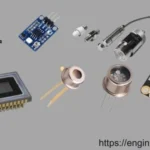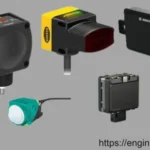What is a Current Sensor?
A current sensor is an electronic device specifically engineered to measure the flow of electric current within a circuit. These sensors can detect both AC (alternating current) and DC (direct current) and provide output signals that can be used for monitoring and controlling various electrical applications.
Current sensors are crucial for energy management, safety, and performance optimization in electrical systems.

How Does a Current Sensor Work?
Current sensors operate by using various principles to measure current flow:
1. Shunt Resistor Method: A small resistance (shunt resistor) is placed in series with the load. The voltage drop across this resistor is proportional to the current flowing through it, which can be measured using an analog-to-digital converter (ADC).
2. Hall Effect Method: This method uses the Hall effect, which occurs when a magnetic field is applied perpendicular to the flow of current through a conductor. The sensor detects the magnetic field generated by the current and converts it into a proportional voltage output.
3. Rogowski Coil: This is a flexible coil placed around a conductor. It measures the change in magnetic field over time, providing a voltage output proportional to the AC current flowing through the conductor.
4. Current Transformer (CT): Used primarily for AC measurements, a CT transforms high currents into lower, manageable values for measurement, typically providing an output proportional to the input current.
Types of Current Sensors
Current sensors can be categorized based on their measurement principles:
1. Shunt Resistors: Simple and cost-effective; used for low-current applications.
2. Hall Effect Sensors: Suitable for both AC and DC current measurement; isolated from the circuit.
3. Rogowski Coils: Ideal for measuring high-frequency AC currents without saturating.
4. Current Transformers (CTs): Common in industrial applications; primarily for AC measurements.
5. Integrated Current Sensors: Combine the sensor and conditioning circuitry in one package, providing ease of use.
6. Clamp-on Sensors: These sensors can be clamped around a conductor without disconnecting it, making them convenient for temporary measurements.
Applications of Current Sensors
Current sensors find extensive applications across various fields, including:
1: Energy Monitoring: Used in smart meters and energy management systems to track electricity consumption.
2: Industrial Automation: Monitor motor and machine performance to prevent overloads and ensure operational efficiency.
3: Power Management: Optimize power distribution in electrical grids and renewable energy systems.
4: Electric Vehicles: Measure battery performance and efficiency during charging and discharging cycles.
5: Consumer Electronics: Monitor power consumption of devices to improve energy efficiency.
Top 10 Highly-Rated Current Sensors:
Current sensors are essential devices for measuring the flow of electrical current in a circuit, providing accurate readings that help in monitoring, diagnostics, and optimization of electrical systems. Whether you’re a DIY enthusiast, an engineer, or a hobbyist, choosing the right current sensor can greatly impact the performance and safety of your projects.
Based on customer reviews, expert opinions, and product features, we’ve compiled a list of the top 10 highly-rated current sensors available on Amazon today.
1: GROVE – 5A Current Sensor (ACS703)
The GROVE-5A Current Sensor is a compact and versatile solution for measuring current up to 5A. Based on the ACS703 Hall-effect sensor, it offers high accuracy and isolation between the measured current and the microcontroller.
It provides an analog output corresponding to the sensed current, which makes it an ideal choice for embedded systems and IoT projects.
Pros:
> Easy to integrate with microcontrollers.
> High precision with minimal offset drift.
> Low-cost, beginner-friendly option.
> Suitable for low-voltage circuits.
Cons:
> Only supports up to 5A of current.
> Analog output might not be ideal for all applications.
2: DROK 100A Current Sensor
The DROK 100A current sensor is highly rated for its capacity to measure up to 100A of current, making it perfect for higher power applications like solar power systems, battery management, and industrial equipment. It uses a hall-effect sensor for isolation and offers a precise analog output voltage proportional to the current.
Pros:
> High current capacity (up to 100A).
> Accurate and stable readings.
> Hall effect-based for complete isolation.
> Wide application range (solar, automotive, etc.).
Cons:
> Requires external power for operation.
> Requires calibration for best accuracy.
3: INVERTIO 20A Current Sensor
The INVERTIO 20A current sensor is an affordable and efficient solution for measuring up to 20A. It features a non-invasive current detection technology, meaning that it can measure current without needing to be wired directly into the power circuit. This makes it a safer and more convenient option for testing circuits without interruption.
Pros:
> Non-invasive design (ideal for retrofitting).
> Simple installation with just a current-carrying conductor passing through the sensor.
> Supports up to 20A of continuous current.
Cons:
> Limited to a 20A current range.
> Digital output may not be suitable for some users.
4: Zio – INA219 High-Side Current Sensor
The Zio INA219 is a high-side current sensor with an I2C interface, which makes it highly suited for integration with microcontroller-based projects. It can measure both current and voltage and has a high level of accuracy, making it perfect for battery-powered applications, energy monitoring, and low-power systems.
Pros:
> I2C communication for easy integration.
> Measures both current and voltage.
> High accuracy with 0.1% measurement error.
Cons:
> Limited to 3.2A of current.
> I2C interface might not be ideal for every user.
5: SparkFun Current Sensor Breakout – ACS723
The SparkFun ACS723 current sensor uses the ACS723 Hall-effect sensor and provides a reliable way to measure current up to 5A. This sensor works on a simple analog output voltage that is proportional to the measured current. It is widely used for motor control, battery monitoring, and other low-power applications.
Pros:
> Small and easy to use.
> Thoroughly documented and supported by numerous tutorials.
> Low power consumption.
Cons:
> Maximum current capacity of 5A.
> Analog output might require additional circuitry for conversion.
6: Honeywell CSLA2CD Current Sensor
The Honeywell CSLA2CD is a high-precision current sensor that uses the Hall effect to measure both AC and DC current. With a measurement range of up to 10A, this sensor is well-suited for applications requiring precise current measurement in industrial, automotive, and power monitoring systems.
Pros:
> High accuracy and stability.
> Operates reliably across a broad temperature range of -40°C to +85°C.
> Can measure both AC and DC currents.
Cons:
> More expensive than alternative choices.
> Needs additional components for integration.
7: Adafruit INA260 Current Sensor
The Adafruit INA260 is a high-performance current sensor that can measure up to 15A of current and provides I2C communication for easy integration. It also measures voltage and power, making it ideal for energy management systems and solar panel monitoring projects.
Pros:
> Measures current, voltage, and power.
> I2C interface for easy microcontroller integration.
> Exceptional accuracy across a broad range of applications.
Cons:
> Limited to 15A of current.
> I2C interface might be too advanced for beginners.
8: Seeed Studio Grove 30A Current Sensor
The Seeed Studio Grove 30A Current Sensor offers a higher current range of up to 30A. Like other Grove products, it features a simple plug-and-play design, making it perfect for hobbyists and developers. It uses a Hall-effect sensor and outputs an analog signal proportional to the current, which can be processed by microcontrollers.
Pros:
> Can measure up to 30A of current.
> Plug-and-play design with Grove connector.
> Reliable Hall-effect sensing.
Cons:
> Analog output might not be precise for high-accuracy applications.
> Requires external voltage reference for full calibration.
9: KY-013 5A Current Sensor
The KY-013 current sensor is a simple and affordable option for hobbyists and DIYers who need to measure current in low-power applications. With a maximum current rating of 5A, this sensor is ideal for basic circuits and small-scale energy monitoring.
Pros:
> Very affordable.
> Simple to use in basic projects.
> Suitable for low-power applications.
Cons:
> Limited to 5A of current.
> Accuracy may not be ideal for more advanced uses.
10: YOKO Tech 50A Current Sensor
The YOKO Tech 50A Current Sensor is designed for high-current applications, such as solar power systems and industrial machines. This sensor can handle up to 50A of continuous current and provides a highly stable output, ideal for energy metering and system monitoring.
Pros:
> High current capacity (up to 50A).
> Ideal for industrial and solar applications.
> Robust design for heavy-duty use.
Cons:
> Requires additional power for operation.
> Relatively expensive.
Conclusion
Choosing the best current sensor for your needs depends largely on the specifications of your project. For those looking for compact, cost-effective solutions, options like the GROVE-5A Current Sensor and KY-013 are perfect for beginners.
For more advanced applications requiring higher current ranges, the DROK 100A and YOKO Tech 50A sensors stand out as excellent choices. Meanwhile, those seeking precise, reliable digital sensors for IoT or energy monitoring might opt for products like the Adafruit INA260 or the Zio INA219.
No matter your application, these top-rated current sensors provide a broad selection of features to meet the needs of hobbyists, engineers, and professionals alike.
Explore More Sensor Technologies
Looking to deepen your understanding of sensor technology? Check out these expert-curated guides to the top sensors in various fields—perfect for students, professionals, and enthusiasts alike:
- Top 10 Force Sensors
Discover the most reliable force sensors used in robotics, automation, and mechanical testing—complete with specs and use cases.
- Top 10 Soil Moisture Sensors
Enhance your agricultural or environmental project with these top-rated soil moisture sensors for accurate water content monitoring.
- Top 10 Infrared Sensors
Explore leading IR sensors ideal for temperature measurement, motion detection, and thermal imaging.
- Top 10 Smoke Sensors
Learn which smoke detectors offer the best performance for early fire detection in homes, industries, and labs.
- Top 10 Ultraviolet Radiation Sensors
Get insights into the best UV sensors for environmental monitoring, medical devices, and sterilization systems.


